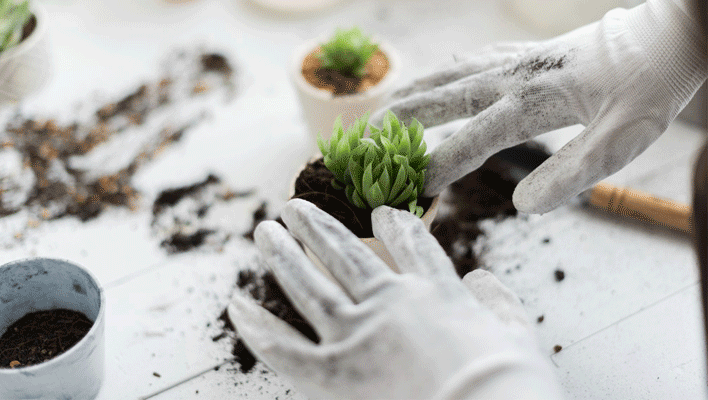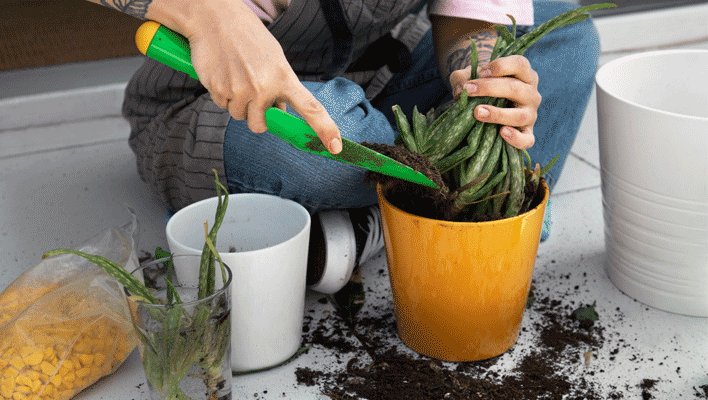Are you a person who is tired of growing plants that get dried out soon or dreaming of growing plants that look fresh, colorful, and lively without much effort? Before thinking about its possibility, this article makes you clearly understand it’s a damn possible thing. Have you ever heard of succulents or the possibility of growing plants from cuttings/clippings from existing ones? How to propagate and grow succulents?
This article will cover everything you need to know to grow a beautiful garden with succulents that soothes your heart and mind.
Succulents: The word was derived from a Latin word, “sucus” meaning juice/sap. Succulents are the plants with parts, usually thickened and fleshy, that store water in arid or soil climates. These are fresh & less water-consuming plants that give a pleasant and pressure-free gardening experience in your home.
What is Succulent Propagation?
It’s the process of growing a new plant from the existing ones through cutting its stem, leaves, roots, or seeds by following simple steps. There are three common types of propagation, namely water, air, and soil propagation. In water propagation, the roots can be seen growing in water through submerging the stems/leaves. The leaves/stems are made to hang with no water or soil and then
kept in the pot after rooting, and finally, in the soil propagation, the roots are developed in a soil pot.

There are three common methods of succulent propagation:
- From leaves: The process of propagating by cutting the leaves of the parent plant
- From Stem: The propagation is carried out through clipping the stem of the parent plant.
- Offset propagation: Snipping off the baby plants from the base of the mother plant and propagating them separately.
Succulents’ genus and species determine what kind of cutting can be taken, as each type of succulent is different. In order to find out which cutting is suitable, one has to experiment and see what happens.
Features of Succulents
Stays Moist: Succulents have the ability to store water in their tissues that helps them survive for a long period even in a water-scarce area.
Fleshy tissues: The thick, fleshy parts of the plant, including leaves, stems, and roots are the primary organs that store water.
Adapts to Arid Environment: Succulents are naturally well adapted to hot , rocky, or dry environments where water is limited and survive.
Budget-Friendly: Wide varieties of Succulents can be propagated very easily with less expense and effort.
Most Popular and Easy Propagating Succulents
- Aloe Vera
- Echeveria
- Dudleya
- Kalanchoe
- Pachyphytum
- Sedum
- Cacti
Why Propagate Succulents
It’s more beneficial compared to other gardening methods, bringing up many advantages in many ways. The following are some of the key advantages of succulent propagation:
Cost-effective: Through propagation, it’s possible to grow plants from the existing plants, which is more budget-friendly than buying a new plant.
Variety Expansions: We can bring up new varieties and add a unique touch to our home/garden.
Healthier Plants: Propagation from a healthy parent plant ensures the healthiness of the next generations and keeps them risk and infection-free.
Reviving the struggling plants: Even a struggling succulent can be saved and brought back through propagating healthy cuttings.
Easy Process: Succulent propagation is known for its easy and simple process, which makes it beginner-friendly.
Low Maintenance Requirements: As the succulent has the power of holding hydration for a long period, it requires less maintenance work.
Prettier Garden: With very little expense, one can set up a wonderful garden with wide varieties of plants that bring up a kind of pleasure on seeing.
Succulent Tool Kit: Tools & Materials Needed:

The succulent tool kits are classified into three broad categories:
- Growing kit: This includes ceramic pots well equipped with drainage holes , potting mix, and a nutrition pack.
- Potting kit: At times of repotting the succulents, a bucket, a shovel , a widger for better handling of succulents, and a bibber to make holes in the soil are required.
- Care kit: In order to take care of the succulents , a water bottle , cleaning brush , dust blower, rake, spade, shovels, etc. will be needed.
Tools in a Nutshell
- Sharp scissors/pruning shears for cutting the stems or leaves properly without damaging the plant.
- Sterilizing agent to disinfect the cutting tools and prevent disease transfer.
- Well-drained pot with specialized soil for the healthy root development of succulents.
- A container or tray for placing the cuttings.
- A little amount of water (filtered/distilled).
- Spray bottle to mist the leaves & maintain the moisture levels.
- Shovels , a bucket, and a cleaning brush.
When to Propagate Succulents
The best seasons to grow succulents are spring and summer, which are considered the active plant-growing seasons. Though it can be grown any time of the year , the results take a bit longer during autumn and winter. Even pruning at your convenience or when it is needed can also lead to propagation.
How to Propagate Succulents from Leaves
STEP 1: Choose a healthy succulent.
STEP 2: Gently twist off the leaves from the stem, ensuring you plug with some stem tissue in it. Instead, use pruning shears or sharp, sterilized scissors to cut off the leaves.
STEP 3: Allow the snipped-off leaves to dry well by placing them in a warm , well-ventilated spot for a few days to a week.
STEP 4: Get ready with a container filled with well-draining soil.
STEP 5: Now place the calloused leaves on the soil, ensuring the cut end is connected with the soil.
STEP 6: Place the container where it receives bright and indirect sunlight, as the direct exposure would lead to drying of the leaves.
STEP 7: Hydrate it lightly every few days once in order to keep it moist.
STEP 8: Be patient and watch the roots developing and bringing out the pups (baby succulents).
STEP 9: Once the pups are grown up enough and the mother leaves, withered , you can transfer it into a new, well-draining pot.
STEP 10: This is how soil propagation through leaf cutting is carried out.
How to Propagate Succulents from Stem Cuttings
STEP 1: Select a healthy stem that is free from pests and not flowering.
STEP 2: Cut the stem using sterilized scissors. In the case of a long stem, make sure to cut the stems into sections that have at least one set of leaves.
STEP 3: Allow the cut part to dry and become callous, which takes merely 2-5 days.
STEP 4: Place the cut stem in a well-potting mix, ensure to place it upright and stable, and then wait a few days to water lightly.
STEP 5: You can witness the rooting from the stem.
Alternatively, Use Water Propagation
- Take a clean glass jar and fill it with pure water.
- Submerge the cut stem into the water but not the leaves.
- Place the jar in bright and indirect sunlight.
- On witnessing the rooting, which takes around 2-3 weeks, you can transfer it into a soil container.
How to Propagate Succulents through Offset

STEP 1: Select an offset that is merely half the size of the mother plant and remove it gently with the pruning shears.
STEP 2: Let the cut end of the offset callous for 1 or 2 days to prevent rotting.
STEP 3: Once the offset is calloused enough , place it in the well-drained soil and water lightly.
STEP 4: Ensure it receives bright and indirect sunlight and spray water only when it is completely dry.
STEP 5: You can witness the growth of the pups from the offset.
Common Mistakes to Avoid
Overwatering: Avoid pouring/spraying excess water on the succulents (especially pups), as they naturally have the ability to stay moist.

Usage of inappropriate soil: Avoid using clay-based/heavy soil that remains more moist; instead, prefer well-draining soil like loam and sandy soil.
Neglect/excess light: Succulents are good at growing with bright and indirect sunlight.
Inappropriate handling of leaves and cutting: Ensure that the cuttings are healthy and properly cleaned out from the parent. Allow it to dry out well before placing it in the potting mix.
Containers without holes: Ensure you make holes in the container in order to prevent root rotting.
Stuffing the succulents together: This may lead to a lack of airflow and cause fungal diseases.
Avoiding Pest Control: Proper care has to be given to the succulents to protect them from pests like mealybugs and spider mites.
Tips for successful Propagation
- Choose the right method of propagating.
- Make ready the tools & materials properly as prescribed before.
- Propagate with ultimate care.
- Avoid unwanted/excess exposure to water and sunlight.
- Stay patient until it roots.
- Repot at the right time.
Frequently Asked Questions
1) What to do in case of leaf shriveling?
The succulents may be thirsty; mist them lightly.
2) Why are the roots of the pups rotting?
You might skip the process of drying or overwatered.
3) Why haven’t the succulents rooted even after weeks?
Some varieties take a long time to root. Be patient and monitor the light & water conditions.
4) Why are my pups experiencing mold growth?
There might be a lack of airflow; check for the moisture level.
Conclusion
Through this article, you now have better knowledge about succulent propagation and understand that propagation isn’t as tough as it seems. No more worries about setting up your dream of a stunning home garden, which can be made easy. Begin small, stay patient, and you will soon witness the beautiful garden filled with a variety of succulents that makes your life colorful.
Happy gardening.

